Angular vs React vs Vue, quick introduction for beginners
Angular, React, and Vue.js enable us to design complex user interfaces. They all offer a modular architecture to extend our apps or even collaborate with other developers easily. Now you might be wondering which one should you learn first?
This question is an understandable worry because it takes time to learn each JavaScript framework. We even have to consider frameworks' future scope and the learning curve.
So today, I'll help you understand the pros and cons of Angular vs. React vs. Vue.js in a step-by-step manner. It gives you a bigger picture of each framework.
After that, I'll help you pick the one is more suitable to learn in 2021.
Before starting the actual comparison, let's have a look at brief overviews of these JavaScript frameworks.
React

React is a JavaScript library used to build the user interface for both - web and mobile apps. The critical point here is that React is not a framework; it is just a library for designing UI.
You can learn more about the difference between a framework and a library here.
React is developed by Facebook, and initially, React was released on May 29, 2013. The latest stable version of React, released on October 22, 2020, is 17.0.1. Facebook uses React in its flagship projects like Facebook, Instagram, and WhatsApp.
React supports component-based development. When you start working with React, the very first thing you create is a component. You can even say that a React app consists of pieces called components. React's approach is similar to the view in the MVC pattern.
It is released under the MIT license, which gives you complete freedom to use or re-distribute it however you like.
The cool thing about React is that it has introduced JSX (a syntax extension to JavaScript). Using JSX code is recommended while working with React. But, you are free to use pure JavaScript to create components.
Facebook maintains React library. That's why React users' community is increasing day by day, and many big companies, including Amazon, Uber, Netflix, Airbnb, etc., have included React in their tech stack.
Angular
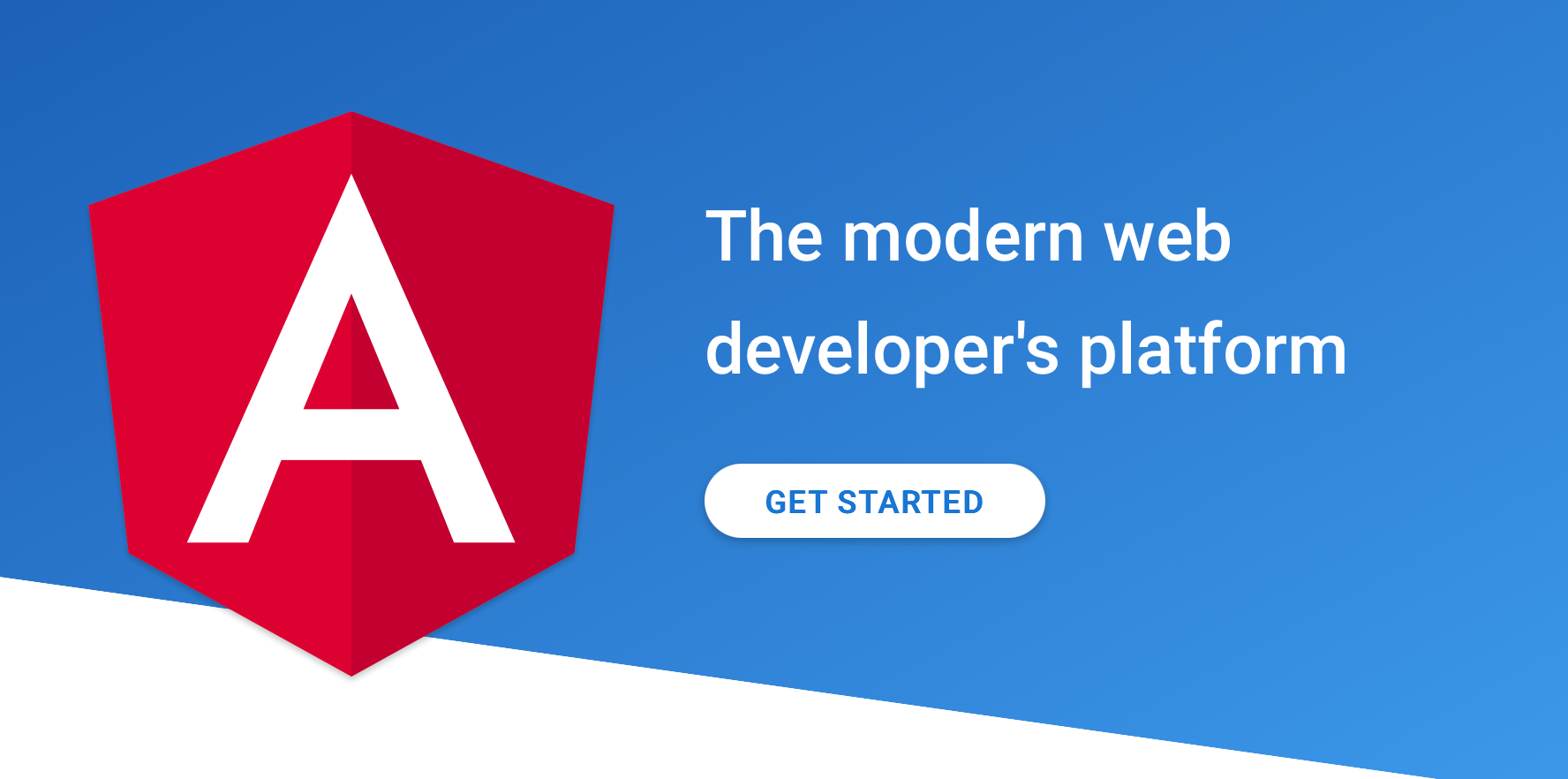
Once known as AngularJS, Angular is an open-source TypeScript based framework used to build the user interface for mobile, web, and desktop applications. It is developed and maintained by Google.
Before we dive deep into Angular's details, it is essential to understand different Angular versions' naming conventions.
Google released angular in October 2010 as "AngularJS." But in 2016, AngularJS was upgraded to Angular 2. Basically, "AngularJS" was the first version of the Angular framework; the next versions have proper version numbers like Angular 2, Angular 4, Angular 5, etc. So, please don't get confused by its version names. These days, we mostly use Angular instead of AngularJS.
Version 11 is the latest Angular version (at writing time) which is released in November 2020. Mostly, Angular releases a new version after every six months.
According to Angular's official website, version 4, 5, 6, 7, 8 are no longer supported. Mostly the latest version of Angular supports its previous version.
The Angular framework is used to build front-end HTML and TypeScript, and it also supports component-based development.
Angular is used by many tech giants like Forbes, Upwork, Deutsche bank, Gmail, Paypal, etc.
Vue.js
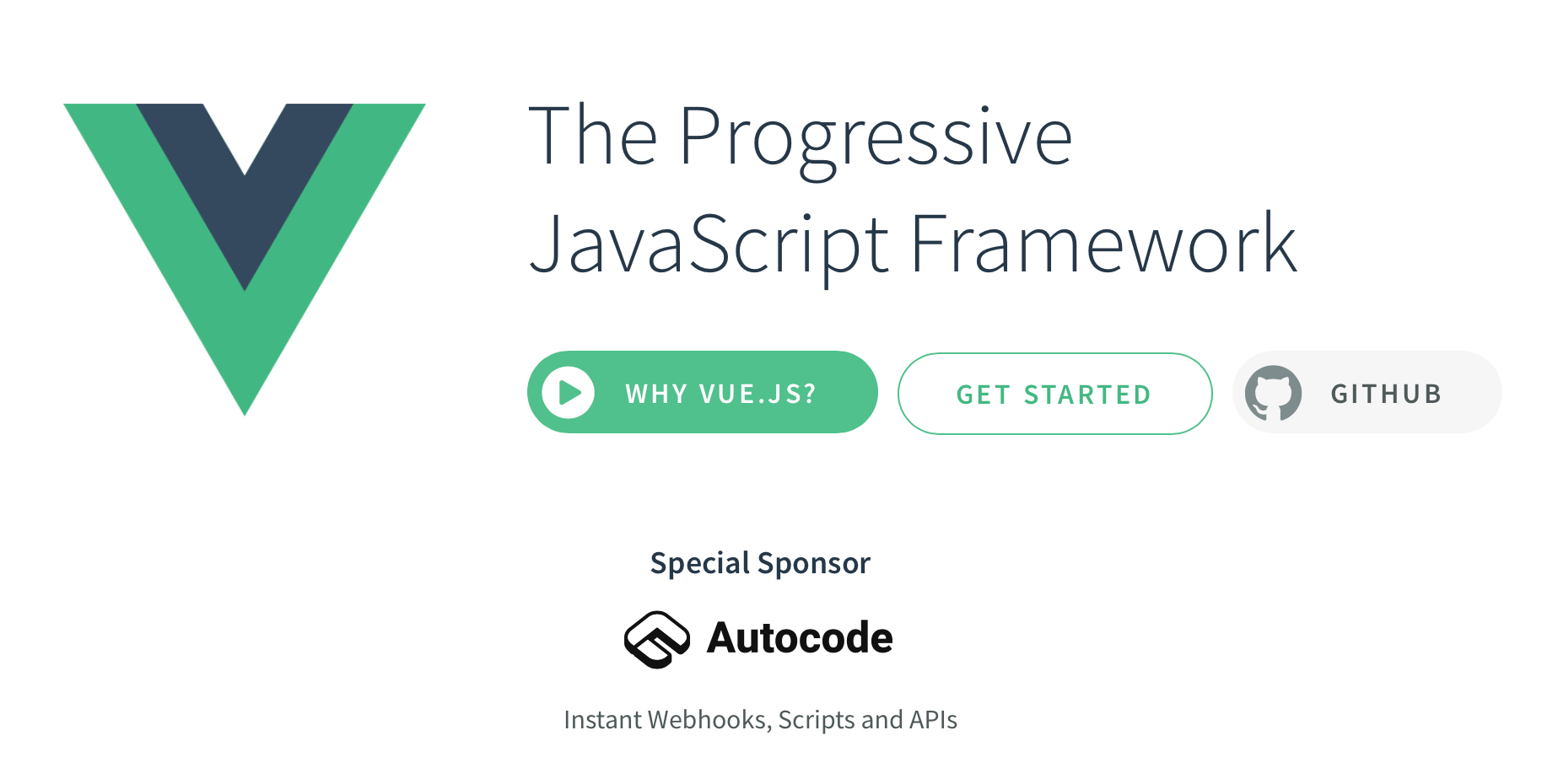
Vue.js is an open-source framework used to develop the user interface for your web and mobile apps. It was developed by Evan, who is a former Google employee, and he released its initial version in February 2014.
It is a very lightweight Framework as compared to Angular and React. It has a growing community, but unfortunately, it has not seen any significant adaptation from big companies because, unlike Angular and React, this framework is maintained by an individual. So, there could be some reliability issues for enterprise-level apps in the future.
The current stable version of the Vue.js is 3.0.5, which was released in December 2020. This new version has complete support for TypeScript, which means that now you don't need any additional tools to write TypeScript code in a Vue.js app.
That was the necessary information about all three front-end frameworks. Now, I will compare these frameworks in detail and discuss the essential characteristics of each.
I will also give my point of view at the end of this blog post.
Popularity of Framework
Before starting to learn new skills or enrolling in a degree, we consider their popularity. At first, we gather information about all frameworks and then make our decision.
The same process applies while selecting the best front-end framework.
GitHub and Google trends are the most authentic sources from where we can get information about the popularity of the framework, and the below results are based on these sources.
GitHub gives you meaningful data like stars and contributors of the framework, and from here, we can analyze the popularity of the framework.
|
Framework/Library |
Stars |
Contributors |
|
Angular |
71.5k |
1364 |
|
React |
165k |
1537 |
|
Vue.js |
180k |
382 |
Similarly, Google trends also show the popularity of the framework in the form of a graph. You can also get the result based on the region where you live. But, for now, this result is based on the global audience.
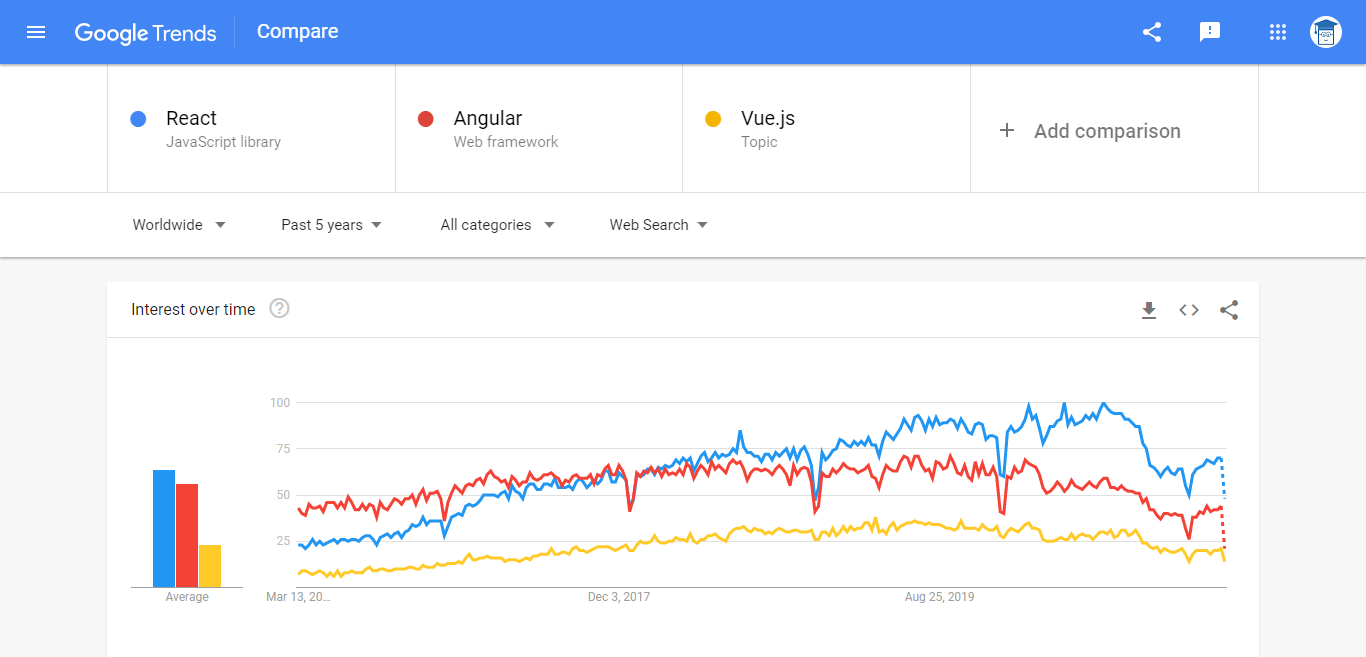
After analyzing the Google trends and GitHub, the ranking of front-end frameworks based on their popularity is as follows:
- React
- Angular
- Vue.js
React
According to google trends, React is the most popular front-end library, with an average "interest over time" of 64 points over the last five years. It is also one of the most popular projects on GitHub, according to its number of watchers, stars, forks, and contributors.
Angular
Angular is the oldest among React and Vue.js, but it comes on the second number with an average "interest over time" of 56 points in the past five years. And by taking into account the number of GitHub stars and contributors, it again secures the second position.
Vue.js
Vue.js is popular on GitHub based on watchers, stars, and fork, but contributors of Vue.js are far lower than the other two frameworks. And on Google trends, it comes in the third position with an average "interest over time" of 23 points.
Ease of Learning
This part will discuss which framework is easy to learn and place them easy to hard.
Vue.js
Vue.js is a lightweight framework, and based on my experience, it is straightforward to learn compared to React and Angular. It is also component-based, but they are easier to use when compared with the other two frameworks. A person familiar with raw HTML5, CSS3, and JavaScript can learn it within a week.
React
React is harder to learn as compared to Vue.js but easier than Angular. It creates problems for some developers who are new to JSX extension. It is not a very big problem, and the vital thing about React, which makes it easy, is that it is unidirectional. It means data flow is in one direction.
Therefore, you also need to learn another library for state management. Currently, Redux is the most popular choice among React developers.
Angular
Angular has a steep learning curve, making it a bit harder to learn than React and Vue.js.
For example, to build a scalable project in Angular, you must learn the concepts, tools, and language below.
- TypeScript
- Angular command line
- Templates, pipes, template expressions, and template statements
- Directives
- Components
- The Angular Router
- Services and Providers
- Modules
- Observables
Working of DOM
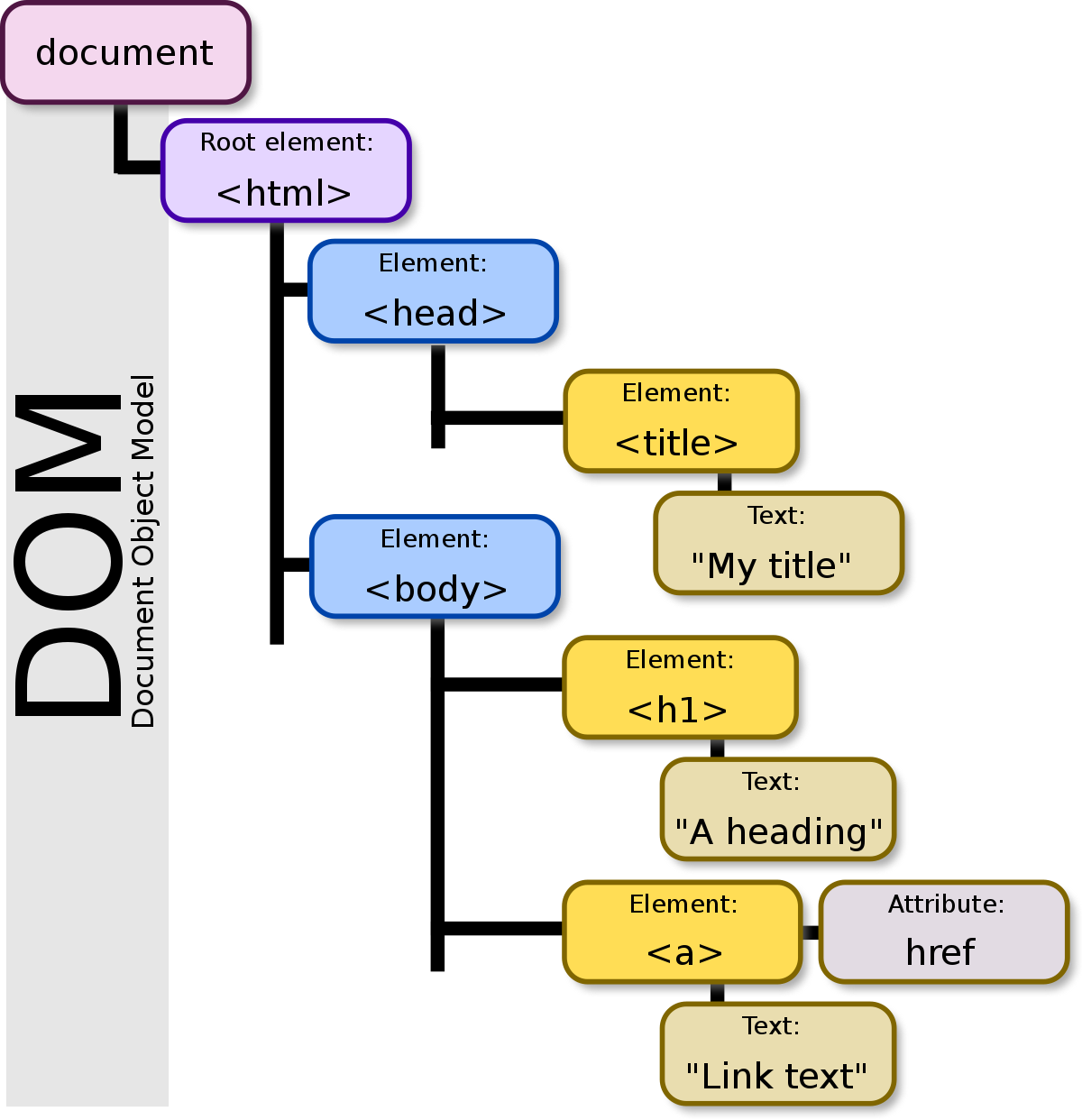
DOM stands for Document Object Module. It is an API used to make changes in a web page using JavaScript without changing the HTML. It defines the logical structure of the page.
The DOM in every framework works differently. Dor more info what is DOM, see this link.
React
React supports virtual DOM as we know that the React app is a combination of components. If we update one element on the page, only that element will be updated, and the rest of the components will remain the same.
Angular
Angular support Real DOM, meaning it updates your complete page even if there is a change in only one element. It makes the app slower, so we use change detection to identify the updated component, to counter this.
Vue.js
Vue.js also supports virtual DOM. So, if any element has new data, we can quickly find that component and change it without affecting other components.
Data Binding
Data binding is a way to synchronize data between model and view. In simple words, whenever you make changes in data, it will reflect in UI.
There are two ways of data binding:
- Bidirectional data binding
- Unidirectional data binding
React
React supports unidirectional data binding, meaning that data flow is in one direction from model to view. Model is the single source of truth in unidirectional data binding. We can also achieve bidirectional data binding in React.js by explicitly setting the value and the onChange handler.
Angular
Angular supports bidirectional data binding; it means that data flows two ways from UI to model and from model to UI. In my opinion, it is easy to work with bidirectional data binding rather than unidirectional.
Vue.js
Vue.js supports both bidirectional and unidirectional data binding. For unidirectional data binding, we have to use the v-model property.
Dependency injection

A dependency is another function that you are pressing need in your class to perform some tasks.
For example, if you have two classes, "model" and "database," And the "model" class fetches data from the "database" class, then we can say that the "model" class has a dependency on the "database" class.
Freecodecamp has a great article about Dependency Injection, check it out!
React
React does not fully support dependency injection. Using JSX, React could support dependency injection, and here it does not need a dependency injection container.
Angular
Unlike React, Angular has complete support for dependency injection, and you can use it while defining a component.
Vue.js
Vue.js supports dependency injection. There is also a third-party project on GitHub called vue-inject that can add dependencies in Vue.js apps.
State management
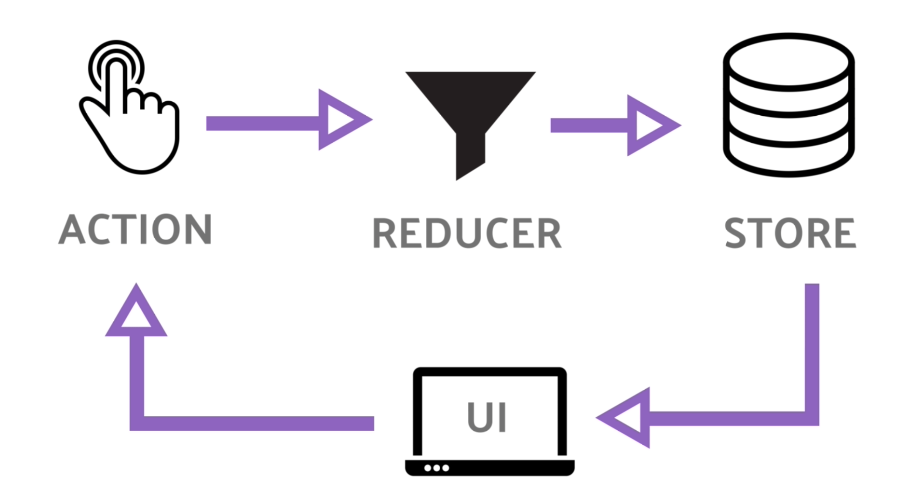
State management is implementing the design pattern that synchronizes the state with all components of the application.
React
React can manage the state of small projects internally. But, for large applications, it becomes a bit difficult. That's why React developers mostly use Redux. It is an open-source state management library.
Angular
Angular also require third-party state management libraries. Most Angular developers prefer NgRx to manage the state of their apps. NgRx helps Angular in maintaining the data flow.
Vue.js
In Vue.js, is not very easy to manage the state. So, here we also use Redux as a state management library.
Mobile development support
Angular, React, and Vue.js all provide you the facility of mobile app development.
React
React Native is the open-source JavaScript framework for native mobile development. It is built using React and is designed by the team behind Facebook. After learning React, it will only take you a week to get familiar with React Native.
Angular
Ionic is an open-source JavaScript framework for native mobile development. It is licensed under MIT, and you can use it to develop both iOS and Android apps. The initial version was released in 2013 and was built on AngularJS and Apache Cordova.
Vue.js
Vue.js doesn't support native mobile app development, but there are some solutions through which you can build mobile apps for iOS and Android. You can use NativeScript and Capacitor, a project of the ionic team, and Vue.js to develop native mobile apps.
Supported Tools
React
React is developed by the big tech giant Facebook. It is supported by multiple testing tools, code editors, and third-party software.
NightmareJS, Jest, and Protractor are the testing tools that support React. It is also supported by code editors like Sublime Text and Visual Studio Code.
Angular
Many third-party tools also support Angular. For example, you can create an Angular project using any modern code editor like Sublime Text, Visual Studio Code, etc. Whereas Karma, and Mocha are some of the testing tools that support Angular.
Vue.js
As we all know that Vue.js does not have the backing of any big tech giant, still it has a support of testing tools like Jest, and it also runs on all popular code editors, which supports JavaScript.
Conclusion
I tried my best to explain the most important things to consider while selecting a JavaScript framework in the earlier points.
If you are new to HTML5, CSS3, and JavaScript, then start with Vue.js. If you have a good understanding of these languages and want to earn more money as a freelancer, go with React.
In case you want to work on big projects (e.g., an enterprise-level application), then Angular is far better. Mostly, Angular jobs are available in big tech companies.
Now, what if you only want to learn one framework and start your career in it?
In 2021, I highly recommend using React because of its vast market share.
Now, there are tons of job opportunities available on freelancing platforms (e.g., Upwork and Fiverr) as well as many of them are office-based.
I hope this guide will help you select the right framework for your upcoming projects and even if you want to make a career in any of the above frameworks.

